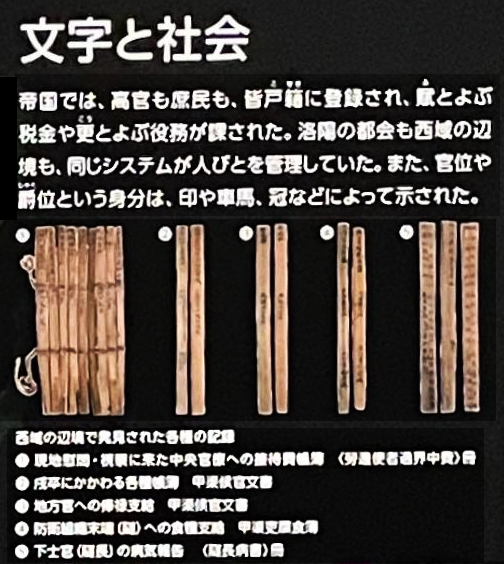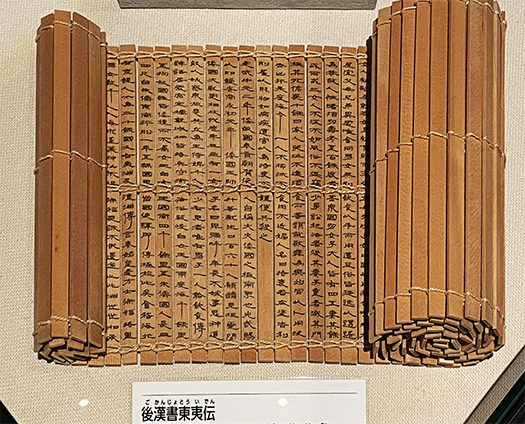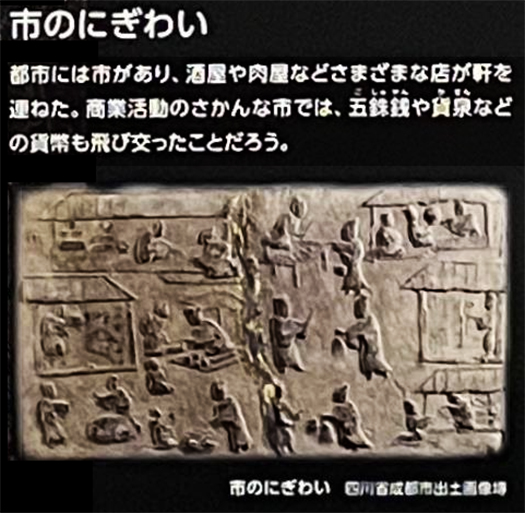



邪馬台国論争、日本王権の古代史ではさまざまな研究がされているけれど、
いまだに「通説」と言われる決定打は出てこない。
とくに古事記・日本書紀の記述で歴代天皇の在位年が人間の体力常識を越えて
異常な高齢生存と記述されているので「神話」とされてきたことが
大きな要素になっているのだと思います。実はこの点について最近、
皇學館大学名誉教授の岡田登氏の解説に感銘を受けました。
歴史作家で直木賞作家の安部龍太郎氏は好きな作家なのですが、
かれが2年前に小学館から出版した「日本はこうしてつくられた:
大和を都に選んだ古代王権の謎」という本の中でこの岡田氏の説が紹介されていた。
〜9代までの天皇の在位年の異常な長さの原因は国家創成期の対外関係、
日本国家を認定させるための唐王朝との外交折衝の結果だという。
唐側には皇帝は「辛酉」の年に天命を受けて国家を創設する思想があって
それに合わせるには、本来1世紀はじめ頃と推認される初代神武天皇が
その思想に合致させるために紀元前660年に即位したことになった。〜
※辛酉というのは西暦年を60で割って1が余る年。革命要素があるとされる。
第10代の崇神天皇について考古的に「纏向遷都」が事実とされてきている。
以降の天皇の在位記録については合理性があるとされているので、
この説に強く惹かれた次第です。
結果、神武東征は1世紀初頭という説が常識的な判断となる。
そしてもうひとつ、日本の国家創生には東アジア、とくに中国王権との
強い緊張関係が非常に重要な要素だったというポイント。
われわれ現代人は、国家は当然の存在という常識バイアスが強いけれど、
言うまでもなく創成期にはそういうバイアスはない。
もっと直接的な「脅威」が存在していたという方が必然性が高い。
国立歴史民俗博物館での展示では、こういう事情を背景説明するように
この時期の中国王権・漢の社会について確証に基づいた解説。
わが国の寺院建築などでよくみられる「四神」イデオロギーが一般化している。
そして「漢字」という文字の体系によって政府の記録が保存され
その文書として「木簡」形式とそれを緊結させる製本方法までが誕生している。
秦の時代からの社会の全把握システムが成熟をみせてきている。
鉄という経済推進力、政治システムの発展進化。
軍事的な脅威という以上に根底的な「危機意識」が日本の支配層に
急速に拡大していったことは体感的に理解できる。
その危機意識が神武という存在に凝集し「東征」を成功させたのではないか。
各地に生成されていた古代地域権力にとってもこの危機認識が共有されていた。
奈良盆地での日本国家生成のリアリティを強く感じる。
English version⬇
The State Society of the Han Dynasty in China in the 1st and 2nd Centuries. 37,000 Years of Japanese Archipelago History-39
The year of Jinmu’s accession to the throne was set in accordance with the idea that heavenly destiny would be revolutionized in the year of the rooster. Responded to the description with diplomatic pressure. Shared recognition of the necessity of a unified archipelago nation. ・・・・・・.
Although various studies have been conducted on the controversy of the “evil kingdom” and the ancient history of Japanese kingship, no definitive “common theory” has yet emerged.
However, there is still no definitive “common theory” that has emerged.
In particular, the reigning years of emperors in the Kojiki and Nihonshoki are described as abnormally old, beyond the common sense of human physical strength, so it has been described as a “myth.
The fact that the reigns of emperors in the Kojiki and Nihonshoki are considered “myths” is a major factor in this.
I think this is a major factor. In fact, I have recently read a book on this point by
I was impressed by the commentary of Noboru Okada, professor emeritus at Kōgakukan University, who is a history writer and Naoki Prize-winning author.
Ryutaro Abe, a Naoki Prize-winning historical writer, is one of my favorite authors.
He published a book titled “This is How Japan Was Created” two years ago from Shogakukan:
In his book “How Japan Was Created: The Mystery of the Ancient Kingship that Chose Yamato as Its Capital,” published by Shogakukan two years ago, Okada’s theory was introduced.
〜The reason for the unusual length of the reign of emperors from the first to the ninth emperor was foreign relations during the founding period of the nation, and
The reason for the unusual length of the reign of the first nine emperors was the result of diplomatic negotiations with the Tang Dynasty to have the Japanese nation recognized as a state.
The Tang Dynasty had the idea that an emperor was to receive a heavenly command and establish a state in the year of the “Xin-Yu” (the year of the rooster).
In order to conform to this, the first Emperor Jinmu, who is estimated to have been around the beginning of the 1st century, was appointed as the first emperor of the Tang Dynasty.
To match this idea, the first Emperor Jinmu, who is estimated to have ascended the throne in the early 1st century B.C., was supposed to have ascended the throne in 660 B.C. ~.
*Hin-Yu is the year in which the Western year is divided by 60 and one is left over. It is said to have revolutionary elements.
It has been archaeologically accepted as a fact that the 10th Emperor Sojin was the first to reign.
Since it is considered reasonable for the reign records of subsequent emperors
I was strongly attracted to this theory.
As a result, the theory that the Jinmu expedition took place in the early 1st century is a common-sense decision.
And one more thing, the strong tension with East Asia, especially with the Chinese royalty, was a very important element in the creation of the Japanese nation.
The other point is that strong tension with East Asia, especially with the Chinese royalty, was a very important factor in the creation of the Japanese state.
We modern people have a strong common sense bias that a nation is a natural entity, but it goes without saying that such a bias existed in the early days of the nation.
However, it goes without saying that we do not have such a bias in the early days of Japan.
It is more inevitable that a more direct “threat” existed.
In the exhibition at the National Museum of Japanese History, as if to explain the background of this situation
The exhibition at the National Museum of Japanese History provides an explanation of Chinese royalty and Han Chinese society during this period, based on evidence.
The “Four Gods” ideology, which is often seen in temple architecture in Japan, has become common.
The Chinese writing system of “Chinese characters” was used to keep government records.
The “wooden letter” format and the bookbinding method to bind them together were born as documents.
The entire system of grasping society that had existed since the Qin Dynasty had reached maturity.
The economic driving force of iron, and the development and evolution of the political system.
The rapid expansion of the Japanese ruling class’s sense of crisis, which was more fundamental than a military threat, was a result of the rapid expansion of their sense of understanding.
This sense of crisis was manifested in the existence of the Jinmu.
This sense of crisis may have coalesced in the presence of Jinmu, who successfully led the “Eastern Expedition” to Japan.
This sense of crisis was also shared by the ancient regional powers that had been established in various regions.
I strongly feel the reality of the formation of the Japanese nation in the Nara Basin.
Posted on 12月 9th, 2022 by 三木 奎吾
Filed under: 日本社会・文化研究, 歴史探訪







コメントを投稿
「※誹謗中傷や、悪意のある書き込み、営利目的などのコメントを防ぐために、投稿された全てのコメントは一時的に保留されますのでご了承ください。」
You must be logged in to post a comment.